
Many aspiring social cartographers of the last few decades (including myself) drew inspiration from the legend of William Wheeler Bunge, Jr. Unfortunately, little information about this geographic and cartographic pioneer exists online. Below’s a biography of the radical cartographer and anti-academic, “Wild Bill” Bunge.
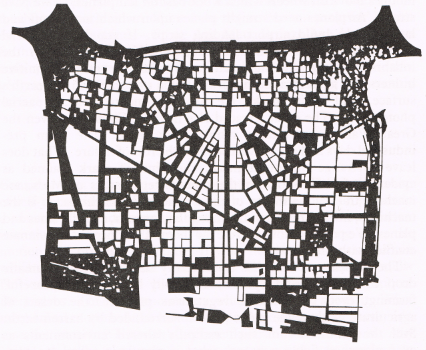
Mini bio
There are unfortunately few sources of biographical information on William Bunge. Here, I rely on the autobiographical first chapter (”Preface and Acknowledgements: Rethinking”) to Bunge’s last published book, the Nuclear War Atlas (1988); UCSB professor Michael Goodchild’s (2008) review [pdf] of Bunge’s (1962) Theoretical Geography; many of Bunge’s articles (see “Further reading” below); and a handful of secondary sources.

Early career
At the start of the Korean War in 1950, a 22-year old conscripted Bunge was teaching atomic warfare at Camp McCoy, Wisconsin. He completed his Masters degree in Geography in 1955 at the University of Wisconsin (natch), where he was influenced by Richard Hartshorne and Arthur Robinson. Establishing a pattern to be repeated throughout his turbulent academic career, Bunge was rejected by Wisconsin and continued his PhD studies at the University of Washington. There, Bunge and fellow grad students Richard Morrill and Waldo Tobler were influenced by the quantitative geographer William Garrison.
Interestingly, this was also the height of the University of Washington’s cartography program. The program led by John Sherman and Donald Hudson was then rivaled only by the University of Wisconsin. Chapter 2 of Slocum et al’s cartography text describes the era well.
Bunge completed his PhD in 1960; his dissertation would become the touchstone in quantitative geography, Theoretical Geography.
Theoretical Geography and the spatial-quantitative revolution
In a 2001 retrospective on the classics of human geography, Kevin Cox wrote that Theoretical Geography is “perhaps the seminal text of the spatial-quantitative revolution” and that (speaking of the broader field of human geography) “if we want to see where we have come from, what our intellectual debts are, there are few better places to start than Theoretical Geography.” Bunge’s work promotes geography as a science and mathematics as the most fruitful language and tool for its study. As the title makes clear, the author was concerned with theory, and believed that simple laws were discoverable about the patterns of social phenomena found on the earth’s surface.
In part, this was a reaction against the idiographic perspective then present in the discipline. Idiographic methods are concerned with describing the infinite variation in these social phenomena rather than discovering generalizable laws common to the entire surface. Bunge thought such an idiographic view would continue to marginalize geography as a science, but received much opposition from geographers who valued the traditional role of description in geographic practice. Later opposition formed against Bunge’s conflation of geometric pattern with explanation; mathematical functions and simple geometric patters couldn’t, in and of themselves, be said to explain anything.
The ideas contained within are too complex and far outside my areas of expertise to cover here; for a better summary of the issues and debates involved, see Michael Goodchild’s 2008 review (pdf). Though his book would become a classic, Bunge had a hard time getting it published stateside, and apparently Torsten Hägerstrand had a hand in its eventual publication by Swedish (”that freer place”) company Gleerup in 1962. Before this, but with his University of Washington PhD in hand, Bunge received his first academic appointment at the University of Iowa in 1960. By 1961, he’d been fired. The next year, with his book published, the activist/academic Bunge moved to the Detroit neighborhood of Fitzgerald to join the Geography Department at Wayne State University.
Detroit: Fitzgerald and the Detroit Geographical Expedition and Institute
Fitzgerald: Geography of a Revolution was published in 1971, a year after Bunge’s infamous Detroit Geographical Expedition and Institute (DGEI) lost the support of Michigan State University. But it was written in 1967, the year before Bunge formed the DGEI, so will be covered first.
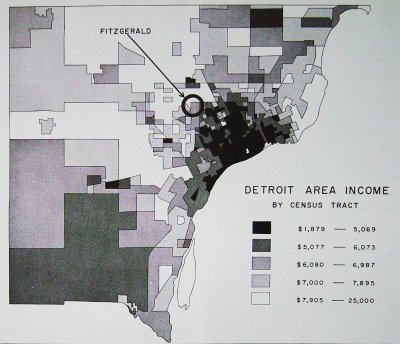
Fitzgerald is an experimental work of urban geography, and one of the most impressive scholarly works I’ve seen. The delay in publication was due to the book’s odd size (23 x 29 cm), format (text, photos, and maps of divergent scale and symbology) and content (very critical of the pervasive racism Bunge seemed to find everywhere). Bunge describes Fitzgerald thusly:
Fitzgerald: The Geography of a Revolution is a humanist geography, describing Fitzgerald, a community in Detroit. The book is science: its data are maps, graphics, photographs, and the words of people. But the book also makes a value judgment — the desirability of human survival — and thus transforms itself into a steel-hard hammer of humanism.
Fitzgerald’s history is traced from the first white settlers arriving in 1816 to the racial tension and revolution Bunge saw taking place around him in the 1960s.
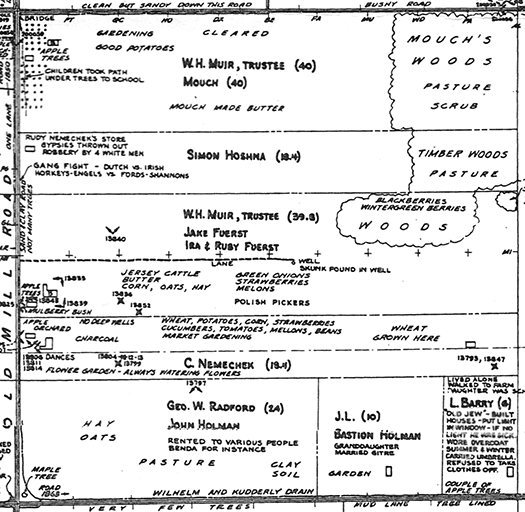
Much of Bunge’s cartographic theory is contained in the foreword to the book. Speaking of a historical farm map created for the book (portion above):
Maps attempt to integrate over time, that is, maps assume an average span of time. This means that nothing that moves is mapped, and therefore property is inherently preferred over humans…In order to restore truth to the map it is necessary to achieve a fiction of accuracy through an assumption, namely that the map is drawn at an exact instant of time. In this case, the time is June 20, 1915 at 2 p.m. on a sunny day. This fiction freezes the men and horses on the roads, the strawberry pickers in the fields, as well as the crops in rotation and the animals in pasture. This restores life to the dead map of property.
Bunge wasn’t a passive observer of the revolution taking place in Fitzgerald. He was an active member of the Fitzgerald Community Council and developed deep connections in the neighborhood; this laid the groundwork for the Detroit Geographical Expedition he would later found (more below). Here, Bunge at a block club meeting in his Fitzgerald home:
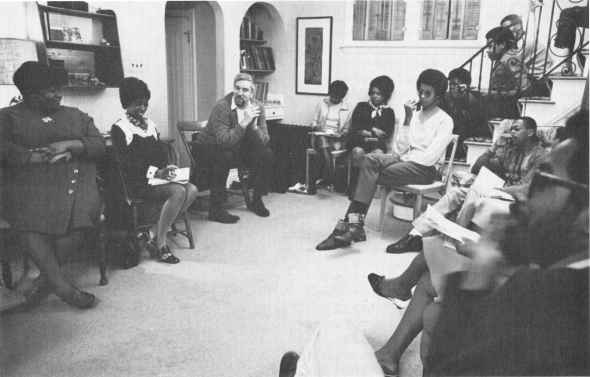
And Bunge in Fitzgerald doesn’t merely describe; he advocates. Here, Bunge on cannabis:
The confusion between marijuana and heroin and other hard drugs seems self-serving on the white adult society. Marijuana grows so easily and abundantly that the apparatus of provision is uncomplicated. It is almost like air, a free resource. Further, unlike alcohol, marijuana seems to produce no aggressive outburst, judging from the teenage dances where the odor in the men’s room indicates its use. It has been argued that marijuana leads to heroin and other hard drugs, but cause and effect in this case is murky since baby’s milk also leads to heroin in the sense that it always precedes it.
The above must smack of the idiography Bunge opposed with Theoretical Geography. Bunge tried to preempt such criticism by insisting on the “disciplined objectivity” of Fitzgerald and the generalizability of the story:
Another major technical difficulty is the generalizability of the story. What can we learn about America from studying a core region of only one square mile? At first it was thought that especially the historic geography would be very spotty and unrepresentative of America, but discovery after discovery gradually reversed this apprehension. Who could possibly believe that this region was typical of all America? Would one square mile in the middle of Cincinnati or Miami turn up Indians, land speculators, gypsies black pioneers and so forth? Yes, if it were studied deeply enough.
Fitzgerald’s reception at the time wasn’t great. Bunge attributed all negative responses to racism and entrenched conservative attitudes within academic geography at the time. Legitimate criticism actually centered on the experimental method employed, Bunge’s generalizations of white racism, and the conclusions drawn from a square mile study area. Further, Bunge’s loving but at times simplistic descriptions of “black culture” would now appear politically incorrect or as unfounded/inaccurate as any racialist descriptions.
Detroit Geographical Expedition and Institute
Besides Theoretical Geography, Bunge should be most well known for the radical mapping + educational mission undertaken in downtown Detroit between 1968-1970 under the name Detroit Geographical Expedition and Institute. Bunge formed the DGEI with a poor 18-year old resident of Fitzgerald, Gwendolyn Warren (below at 16, from Fitzgerald).

Variously affiliated with the University of Michigan, Michigan State University, and Wayne State University, the Expedition attempted and at times succeeded in providing free college courses to young inner-city Detroit residents. Bunge wanted to do research in the black community while also teaching the skills necessary for them to conduct research for themselves. All volunteer faculty were used, and the Expedition was generally successful in attracting experts from across the U.S. to teach courses at facilities freely provided on Wayne State University’s Detroit campus.
Classes focused on geography and geographic skills. Two courses — Cartography and Geographical Aspects of Urban Planning — provided the context for perhaps the Expedition’s greatest achievement: A Report to the Parents of Detroit on School Decentralization [pdf] (1970). Expedition participant and Geography professor Ronald Horvath describes the relevance of cartography to the students:
The material covered just did not seem terribly important to the students. Before the request came in to do the decentralization study, a lot of effort had to be spent shoring up the morale of the students, who had real difficulties just showing up to even free classes — some came hungry, others couldn’t afford bus fare, one student had been living in a car for five weeks. Learning how to make a clean line, lay a rip-a-tone pattern, or design a map with the right Combination of point, area, and line symbols did not seem to be critical knowledge to members of a survival culture. But the school decentralization study made sense. The next three weeks both saved and came to define the potential of the Expedition.
The decentralization report — rich in graphs and maps created by Bunge and the Expedition’s students — was adopted by a community group and forced the Board of Education to respond to charges that its school districting plans were illegal. The Expedition released a few other documents using cartographic experimentation as a weapon of social justice, including the “Geography of the Children of Detroit”. At its height in the Spring of 1970 the Expedition enrolled nearly 500 inner-city students in 11 different courses. By that fall, zero courses were being taught and the Expedition was effectively over, having lost the support of Michigan State University.
Leaving the U.S.
Below you’ll see Bunge’s name on part of an infamous listing of 65 “radical” speakers compiled in 1970 by U.S. Representative Richard H. Ichord, then chairman of the House Un-American Activities Committee. This blacklist was the subject of much controversy and a federal court order actually prohibited official government publication of the names of these anti-war protesters and/or open communists.
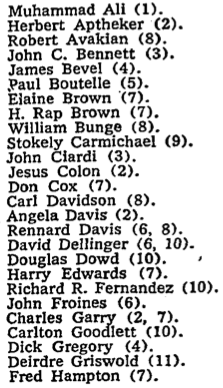
After his brief (1960-61) stint at the University of Iowa, Bunge was employed for the Fitzgerald and early DGEI days by Wayne State University (1962-69). He was fired from Wayne State University when his attempts to draw black geographers to the department rankled administrators. Unemployment allowed Bunge to travel to campuses in the U.S., Canada, and Britain on his “have map, will travel” campaign. He used an overhead projector to show “peace maps” as a protest against U.S. militarism (these would evolve into the Nuclear War Atlas; see below). Bunge’s speeches during this period drew the attention of Representative Ichord, and the resulting blacklist made Bunge basically unemployable in U.S. academia.
Bunge moved to Canada and had two more brief stints in academia: at the University of Western Ontario (1970-71) and York University (1972-73). This period was Bunge’s most prolific with regard to non-book publication: I count 12 single-author pubs between 1970 and 1974. In this period, Bunge formed a few short-lived expeditions on the Detroit model: the Society for Human Exploration (1971-72), Toronto Geographical Expedition (1972-73), and the Canadian-American Geographical Expedition. Bunge touted such expeditions as the highest calling for the geographer.
I’ve barely done justice to the history, theory, and impact of these urban expeditions. I recommend seeking out the primary and secondary material on the period (see “Further reading” below), particularly Ronald Horvath’s “The ‘Detroit Geographical Expedition and Institute’ Experience”, Bunge’s “The First Years of the Detroit Geographical Expedition: A Personal Report”, and the decentralization study linked above.
Later in the decade, now outside both Canadian and American academia, Bunge would become a cab driver in Quebec. Though an odd turn for such an influential geographer, Bunge had previously compared cab drivers glowingly to the native guides who led explorers across the Americas and Africa. Bunge had elsewhere praised cabbies: the “regions within cities are better known by cab drivers than by ‘urban geographers’”. Bunge lived in Arthabaska, Quebec from some time in the late 70s to some time in the early oughts.
The 80s and the Nuclear War Atlas
William Bunge was published thrice in the 1980s: one article (correction: found another article, though it was originally submitted in the late 70s), one epilogue, and one book. The book, Bunge’s latest, was also his most experimental and map-heavy work. The intro contains a limited biography of the man himself. Further chapters include remixes of his previous works, copious maps (see “Maps” section below), and Bunge’s ruminations on the potential destructiveness of U.S. and Soviet nuclear power.
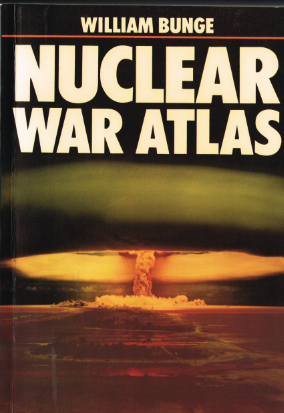
The atlas started as a poster (from Martin Dodge’s blog):

In the appendix, Bunge called Geography the “Queen of the Peace Sciences”:
Interestingly, geography, a subject currently in low academic status, dying out in one university after another, can actually make a serious claim to be the ‘queen of the peace sciences’ — not out of our innocence, but rather out of our guilt. It is the quintessential war science. This might account for its decline. Today, who needs more expertise on how to kill people?
The Nuclear War Atlas is a significant geographic and cartographic work. Again, I do it little justice. The atlas may have had more traction had the wall not fallen a year after its publication, but the maps and text within are still necessary reading for any radical geographer or social cartographer.
Back to the USSR
Since the Nuclear War Atlas little has been heard from William Bunge. Nothing was published in the decade until 1998. By this time Bunge’s social liberalism seemed to be verging on Stalinism. His latest published article (that I know of) — 1998’s “Where are the Germans?” — was printed in Northstar Compass, the journal unabashedly dedicated to the re-establishment of the Soviet Union as a socialist state. I can’t find the text of the article (it’s not included in Northstar’s archives for the issue) but its publication was noted in a Spring 1999 edition of MADGEOGNEWS [pdf].
The same article notes that Bunge “was awarded the ‘Representative of the Parti communiste du Québec to the Federal government’ in 1998″.
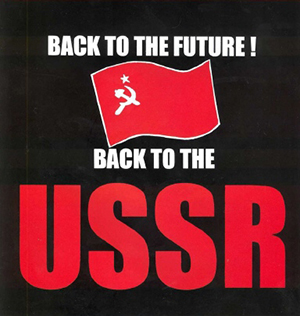
A 2001 letter also contained a bit of revisionist Stalinism. The below was included in some discussion on a World Congress for Solidarity and Friendship with the Soviet People page.
We have a lot of basics in common. We remember and respect the fact that under the brilliant leadership of Joseph Stalin the Soviet Union practically single handedly defeated Hitler. Almost ninety per cent of all the military fatalities sustained by Hitler’s Nazi hordes in World War II were rendered by the Soviets, leaving but ten per cent for all the other “allies.” Many Western war veterans were saved by the defeat of the fascists by the Soviet Red Army.
We are also enthusiastic about the restoration of the USSR since its collapse had practically collapsed most of the left movement worldwide. Philosophically there would be no understanding of even pre-Leninist works, Marx and Engels, without the Soviet press and its publishing of all their works in many languages of the world.
At the World Congress which I shall attend I will try to bring the following question to discussion: “How does religion differ in Fidel Castro’s Socialist Cuba compared to Stalin’s Socialist Soviet Union?”
Certainly Bunge always leaned towards Marx — his later Stalinist leanings should by no means detract from his 30+ years of service to the downtrodden of America, those who’d been failed by the state supposedly dedicated to serving them. Bunge is alive and (I hope quite) well, and I regret missing this document distributed at the 2008 AAG conference in Boston, at which Bunge and I were both rumored to be in attendance.
Maps
But what the hell do I really care about?- maps. Here’s a gallery of works of his I’ve scanned from books and articles or found online.
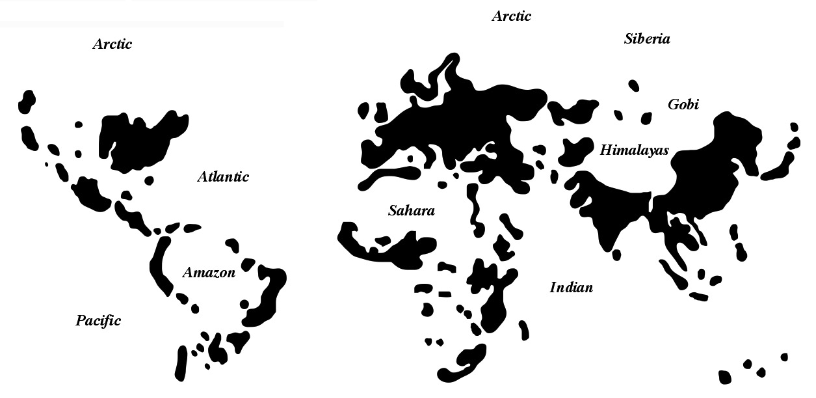
From Professor Krygier’s Making Maps blog: “Redrawn from William Bunge, The Continents and Islands of Mankind. Areas in black have more than 30 people per square mile. Reproduced from Making Maps, p. 160-161″
Fitzgerald and the Detroit Geographical Expedition
Bunge’s Fitzgerald: Geography of a Revolution and the output of the Detroit Geographic Expedition (see bio above) included some of Bunge’s most experimental and powerful maps of Detroit.
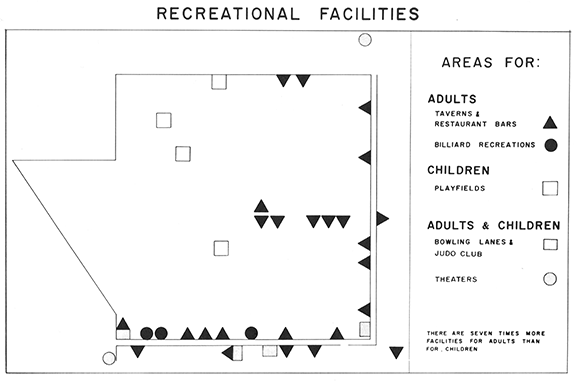
A simple map I scanned from Fitzgerald

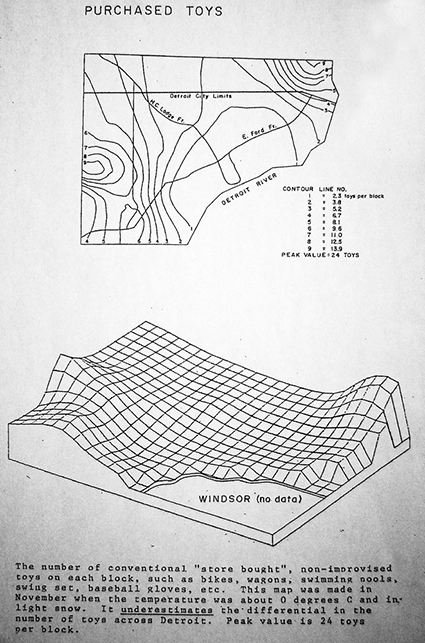
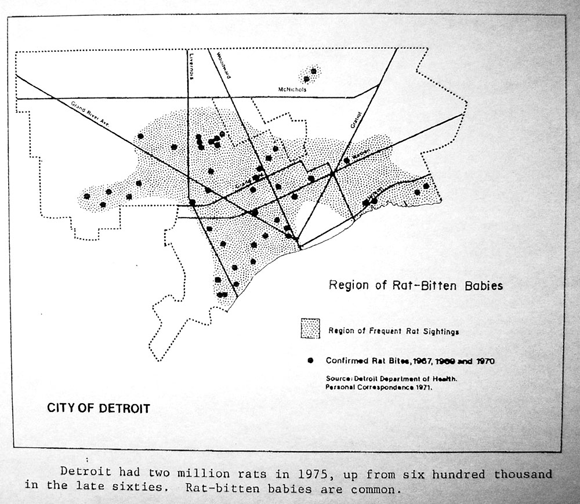
The above three maps were published last December in what I can only assume is [translated here] an excellent post on Bunge’s work in Detroit: William Bunge, le géographe révolutionnaire de Detroit.
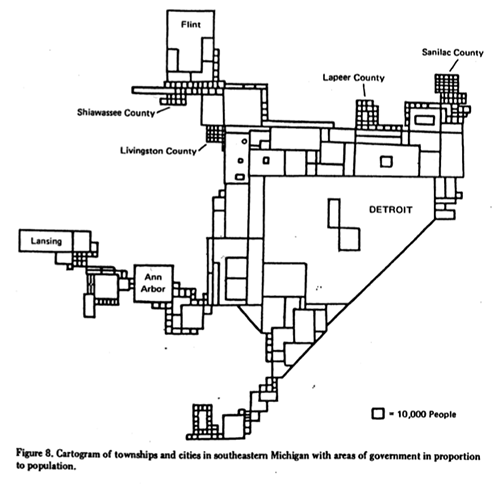
Another example of Bunge’s cartographic experimentation: a rectangular cartogram when the form was quite rare. An image I clipped from the DGEI’s “A report to the parents of Detroit on school decentralization” [pdf]“
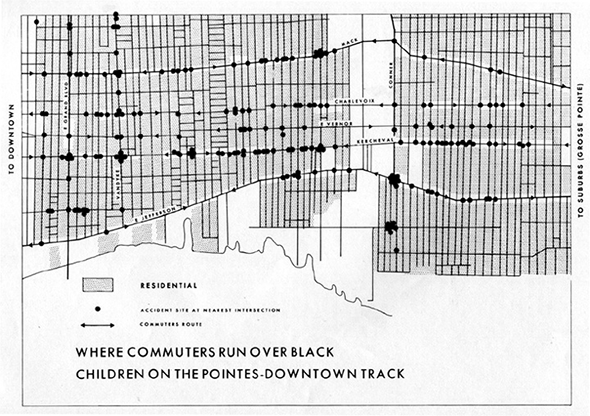
This map is from Fitzgerald, but I snagged it from a post on Krygier’s blog
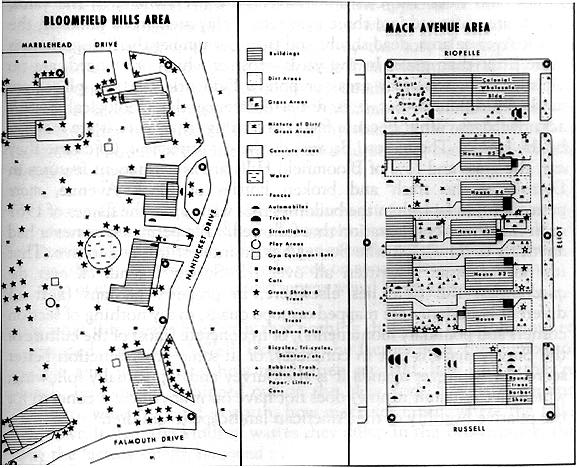
Another map from the DGEI, this time scanned from an ESRI proceedings paper. I can’t make out all the map symbols, but some are dogs, cats, rubbish, gym equipment, bicycles, telephone poles, and broken bottles.
Nuclear War Atlas
Bunge’s Nuclear War Atlas is perhaps his most important cartographic work. Indeed, it is his only atlas (his Atlas of Love and Hate was never realized, not by Bunge anyway). The mostly duotone (red and black) maps contained therein display more cartographic experimentation than any of his previous works. There’s also some pretty weird shit. Bunge notes in the preface:
The color red is used throughout the atlas on the maps to depict death, and green life. This atlas is awash in red as our planet might soon be in death. Hopefully, at last my fellow revolutionaries will show some keen interest in conducting revolution without annihilation.
I had to search quite a bit to find any maps containing green (life).
Here’s a sampling of nine maps I scanned from the atlas, complete with original captions. Bunge’s work contains many redesigns of maps previously included in Fitzgerald or DGEI publications (for example, the “Region of rat-bitten babies” map below).

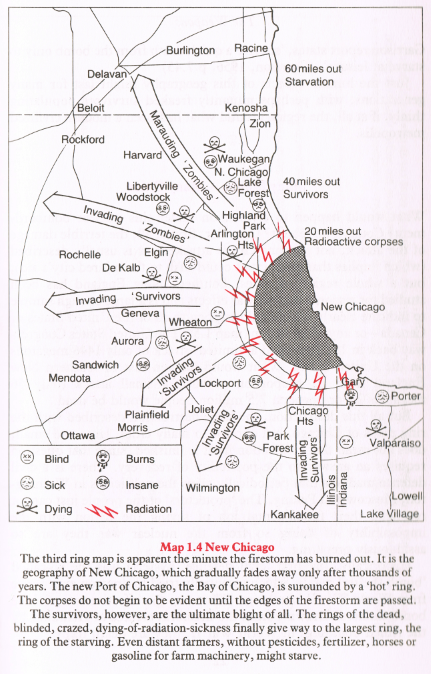

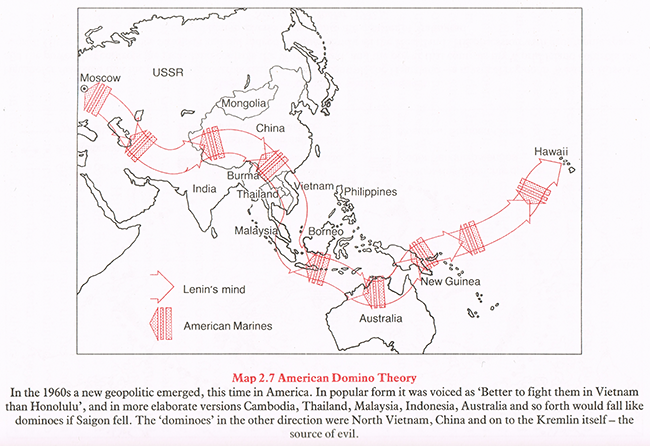
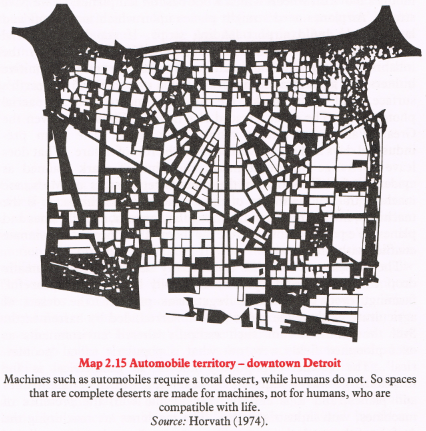
Someone helpfully pointed out to me that (as the source indicates) the above is actually reprinted by Bunge from Ronald Horvath’s (1974) article “Machine Space”
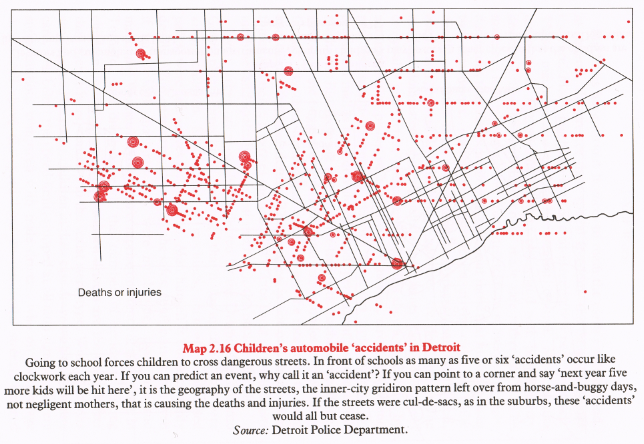
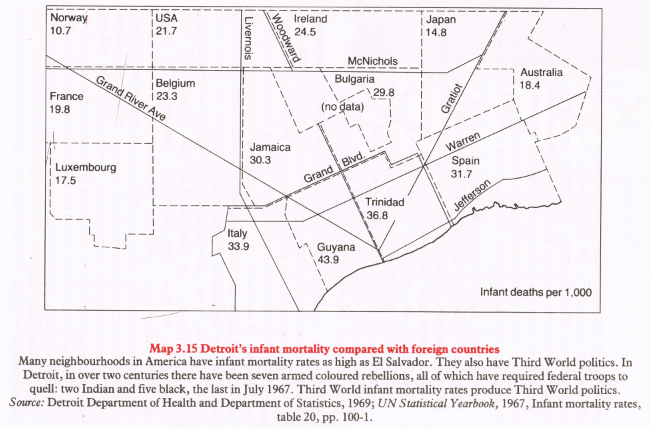
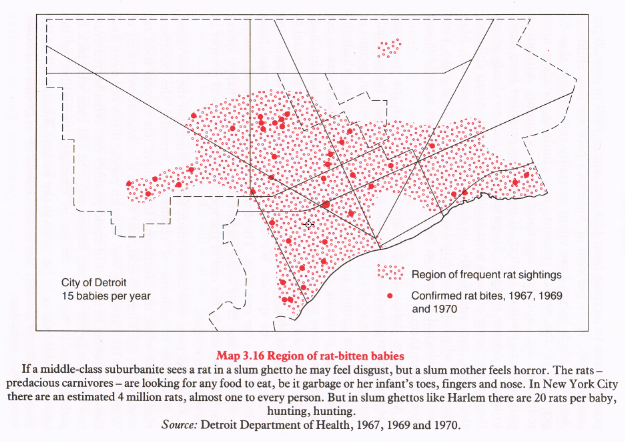

Influence
Bunge’s concept of the Expedition was very influential in geography in the 1970s. Unfortunately, the influence didn’t last long and there have only been minor resurgences since. Still, a small group of radical geographers — particularly those associated with the Antipode journal — have carried on the revolutionary spirit of Bunge’s geography.
Bunge is certainly an influence on academic John Krygier and anti-academic Denis Wood. The former has mentioned Bunge a few times on his blog and his definitional work on maps as propositions (see the sweet Krygier/Wood comic, Ce n’est pas le monde [pdf]) is inspired by Bunge’s advocacy maps of the 1960s. Wood too was influenced by the Detroit Geographical Expedition; his as yet uncompleted Narrative Atlas of Boylan Heights is directly influenced by Bunge in terms of scale, subject matter, and cartographic technique.
I am personally not as convinced as Bunge as to the state’s ability to solve the very real problems about which he writes and maps; and I just can’t get down with his more recent Stalinist leanings. I admire William Bunge primarily as a social cartographer willing to experiment with symbology and as a geographer willing to stand up for his political principles. Ultimately the latter led to him having no place in American academe. This is unfortunate, for his experimental cartography and radical geography writings could have had a much greater impact on critical cartography, public participation GIS (PPGIS), and human geography.
Further reading
By Bunge
Books
- Theoretical Geography. Lund, Sweden: Gleerup. (1962)
- Fitzgerald: Geography of a Revolution. Cambridge, Mass.: Schenkman Pub. Co. (1971)
- Nuclear War Atlas. New York, NY: Basil Blackwell Inc. (1988)
Journal articles and chapters
Bunge certainly shouldn’t be judged by his peer-reviewed scholarly output; in many ways he was an anti-academic who preferred action to being published. Nonetheless, here are all the published Bunge articles or chapters I could find. Links provided are occasionally to full-text content, but most are to references on JStor, OpenLibrary, and similar sources. I throw in a quote or an abstract here and there.
- (with Reid A. Bryson) “Ice on Wisconsin Lakes” (1956) Published by University of Wisconsin Dept. of Meteorology
- “Patterns of Location” [pdf] (1964) Discussion paper of the Michigan Inter-University Community of Mathematical Geographers, no. 3
- “Geographical Dialectics” (1964) Professional Geographer 16, pp. 28-29
- “Racism in Geography” (1965) The Crisis (NAACP magazine) October, pp. 494-497
- “Locations Are Not Unique” (1966) Annals of the Association of American Geographers 56, pp. 375-376
- “Gerrymandering, Geography, and Grouping” (1966) Geographical Review 56, pp. 256-263
- “Fred K. Schaefer and the Science of Geography” (1968) Harvard Papers in Theoretical Geography, Special Papers Series, Paper A
- “The First Years of the Detroit Geographical Expedition: A Personal Report” (1969) field notes, discussion paper no. 1, pp. 1-59
- “A report to the parents of Detroit on school decentralization” [pdf] (1970) Detroit Geographical Expedition and Institute
- “Geography of the Children of Detroit” (1971) field notes, discussion paper no. 3
- “The Geography” (1973) Professional Geographer 25, pp. 331-337
- “The Geography of Human Survival” (1973) Annals of the Association of American Geographers 63, pp. 275-295
- “Ethics and logic in geography” (1973) In R. J. Chorley (ed.), Directions in Geography, London: Methuen, pp. 317-31
- (with Robert Sack) “Spatial Prediction” (1973) Annals of the Association of American Geographers 63, pp. 566-569
- “Urban Nationalism: An Example from Canada” (1973) La Revue de Geographie deMontreal 27
- “Exploration in Guadeloupe: Region of the Future” (1973) Antipode 5, no. 2, pp. 67-73
- “Regions Are Sort of Unique” (1974) Area 6, no. 2, pp. 92-99
- (with Donald W. Fryer) “A Geographer’s Inhumanity to Man” (1974) Annals of the Association of American Geographers 64, no. 3, pp. 479-484
- “Practical Applications of Theoretical Geography” (1974) Published by the University of Iowa Dept. of Geography
- “Fitzgerald from a Distance” (1974) Annals of the Association of American Geographers 64, no. 3: pp. 485-489
- ( with R. Bordessa) “The Canadian alternative : survival, expeditions and urban change” (1975) Published by the Dept. of Geography, Atkinson College, Toronto
- “The Point of Reproduction: A Second Front” (1977) Antipode 9, no. 2, pp. 60-76
- (with John D. Nystuen) “The Philosophy of Maps” [pdf] (1978) Michigan Inter-University Community of Mathematical Geographers, Discussion Paper no. 12
- “Perspective on Theoretical Geography“ (1979) Annals of the Association of American Geographers 69, no. 1: pp. 196-174
-
“The Cave of Coulibistrie” (1983; originally submitted 1978) Political Geography Quarterly 2, no. 1: pp. 57-70
Geography and politics are intertwined in a study of a single small Caribbean settlement, Coulibistrie, on the windward island of Dominica. The sense of the place is provided through a sympathetic description of its rhythms, its people, their reactions to their poverty and their survival strategies. Political movements from Dreadism to Socialism are discussed in this specific context, and the position of women and children analysed. Political strategies are evaluated and the conclusion proposes a pro-children dialectical experiment of allying Marxism with the Catholic Church.
- “Geography is a field subject” (1983) Area 15, no. 3: pp. 209
- “Epilogue: Our Planet is Big Enough for Peace but Too Small for War” (1986) in R. J. Johnson and P.J. Taylor (ed.) A World in Crisis?: Geographical Perspectives, Oxford: Basil Blackwell
- “Where are the Germans?” (1998) Northstar Compass 7, no. 6
- “Author’s response: geography the innocent science – a completed geography
awaiting its birth in print” (2001) Progress in Human Geography 25, no. 1, pp. 75-77So what is the state of geography today? It is in a mess – hyphenated, obfuscated, as confused as it is confusing. Why? Society is itself degenerating. The culture is coarse, vulgar, prostituted, chaotic, ‘dummied down’. We are in desperate need of intellectual reinforcements, and geography can help some.
Letters to the editor
- “A Geological Decision” (1962) Iowa Defender (Iowa City underground newspaper, 1959-1970), 5 January, 1, 3, 4
- “When to Organize” (1965) New York Times, 27 June, E11
- “Soviet Consumption” (1965) New York Times, 18 August, pp. 34
By others
Bunge has been covered in many divergent sources — below are just a few.
Articles
- Ronald J. Horvath (1971) “The ‘Detroit Geographical Expedition and Institute’ Experience”. Antipode 3, 1, 1
- Richard Peet (1977) “The development of the radical geography in the United States” in R. Peet (dir.) Radical Geography, alternatives viewpoints on contemporary social issues. Chicago: Maaroufa Press
- A. Merrifield (1995) “Situated Knowledge through Exploration: Reflections on Bunge’s ‘Geographical Expeditions’”. Antipode 27, no. 1, pp. 49-70
- K.R. Cox (2001) “Classics in human geography revisited: Bunge, W., Theoretical Geography. Commentary 1.” Progress in Human Geography 25, no. 1, pp. 71-73
- M.F. Goodchild (2008) “William Bunge’s Theoretical Geography” [pdf]. In P. Hubbard, R. Kitchin, and G. Valentine, editors, Key Texts in Human Geography. Los Angeles: SAGE, pp. 9–16. [450]
Blog posts
- Cyber Badger Research Blog (by Martin Dodge): “William Bunge’s Nuclear War Atlas“ (October 2006)
- New Maps of Ulster: “William Bunge” (June 2008)
- John Krygier’s Making Maps blog: “Making Advocacy & Humanitarian Maps” (June 2009)
- Le Monde diplomatique: “William Bunge, le géographe révolutionnaire de Detroit“ (December 2009)
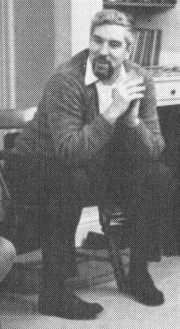

38 Comments
Denis Wood’s Atlas of Boylan Heights - under an as of yet undecided title - will be published by art publisher Siglio Press later this year. http://deniswood.net/
jk
The Soviet Union did defeat the Nazis basically single-handedly. Which is not to defend the Stalin-love, of course.
Zach,
Thanks for putting this together. I have always been interested in Mr. Bunge, but, as you say, details of the man are scarce.
I hope that he continues to serve as an inspiration to the coming generations of cartographers. I think changes in technology have made it much easier to embark upon the kinds of projects that interested him. Though digital technology is still largely confined to middle and upper classes, it’s becoming easier and easier to get data about people’s lives and experiences, and to use maps to empower them.
Good to know that Bunge’s work is still appreciated.
Just watched the documentary “Requiem for Detroit” which makes so many connections to the last century of change - Ford and the industrial complex, urban migration, residential segregation, and now the prospect of a diminishing city. So although the canvas is somewhat larger, it readily supports Bunge’s contention about the Fitzgerald project that a whole history can come from a square mile if you dig deep enough.
This is a fantastic post. Thanks for your hard work!
you’re a wild man. i love bill bunge. waldo gave me a white paper he wrote on a typewriter called ‘metacartography’ including some early isochrone maps of seattle. he still drives a cab in toronto, i think…
Please consider adding your blog information to the wikipedia page on Bunge. It isn’t great, but it is where kids go for basic ‘jumping off’ information.
Your article is wonderful! I appreciate your time and effort preserving ‘Fitzgerald’. Copies of the book are hard to find. I found a few for about $200 on abebooks.
Regards,
Dalynda from Norman, OK
i had the wonderful visiting bunge two times.
there isn’t enough room to repeat the yarns bunge and his wife donia spun along with the file files of published and unpublihed works bunge wrote. bunge also has william warntz’s papers which i was able to review. my unfinished thesis is on bunge. good hunting for those looking for his works. the government is still keeping an i on him. if you doubt this contact dr. david nemeth at the university of toledo, toledo ohio
I was a grad student at the u of w from 1958 through 1960 and was well acquainted with bill both academicaly and socialy In 1959 I along with bob alexander and bill climbed Mt Rainier. Bill was very pleased with our conquest of rainier. On the long drive back to seattle bill became very intropesctive about his relationships with his father.He essentially said he was very appalled and disgusted with his father’s unfettered capitalistic schemes and eploitations According to bill his dad was very influental in Wisconsin commrce and politics and had very little concern about any social consequences of his exploits .If one is to to begin to understand bill’s political position this would be the place to start.However bill is a very very compex person and I am sure this is just a little insight to bill’s complex personality I trust that personal bit of biil’s life will be treated with discretion and respect
Zach-
I am pleased to see what you have been posted, having editing the first three publications of the Detroit Geographical Expedition. Bunge was a difficult person to work with but certainly memorable.
I do wish you would correct the typo (capitalized) in your quote from Ron Horvath:
“Ronald Horvath describes the relevance of cartography to the students:
The material covered just did not seem terribly important to the students. Before the request came in to do the decentralization study, a lot of effort had to be spent shoring up the morale of the students, who had real difficulties just showing up to even free classes — some came hungry, others couldn’t afford bus fare, one student had BEER (been) living in a car for five weeks. Learning how to make a clean line, lay a rip-a-tone pattern, or design a map with the right Combination of point, area, and line symbols did not seem to be critical knowledge to members of a survival culture. But the school decentralization study made sense. The next three weeks both saved and came to define the potential of the Expedition.
Charlie Ipcar
I had the wonderful visiting bunge two times. Very interesting article. Keep your good work guys!
Outstanding work - I too have only found interesting snippets on Bill Bunge before this post. After reading this, I tracked down a couple of his books at Amazon and bought them.
You know, Bill is still alive.
I have lost touch, personally, but someone out there, you professional geographers, needs to make the effort to find and to honor him. I got him to show, briefly. at the Boston AAG.
Maybe NY meetings. Give him the Blaut Lecture.
Think about it
cpakatiff@yahoo.com
wow, this is like looking into Chapman’s Homer. The technology is there, but thinking like his is like a flower opening.
Thanks so much for this fascinating information. -Liz Kueneke
i enjoyed your posting on bunge!!!! i am finishing me thesis on him. i had the chanse to visit him twice at his home.
i tried to make copies of the newspaper articiles, but couldn’t. was wondering if you could email them to me?
thanks
david
It has been so difficult to find anything about it. Thanks for compiling this, as well as the maps. It would be great if he would attend one of the AAG meetings. New York is pretty soon, if not this one, perhaps another.
It’s a pity you don’t have a donate button! I’d certainly donate to this excellent blog! I suppose for now i’ll settle for bookmarking and adding your RSS feed to my Google account. I look forward to brand new updates and will share this blog with my Facebook group. Talk soon!
This continues to be the best place to learn about Bunge and the Detroit expedition. Which, by the way, may be starting up again soon.
This is a terrific website. Bunge is an extraordinary person. At the time, Theoretical Geography was brilliant. It and The Canadian Alternative (Bunge with Bordessa)are two of the best books ever written in geography. Fitzgerald is also very interesting and can often be found in local public libraries.
Hello, this is a great resource on William Bunge and his work. Thank you very much …
Garrett
Things don’t quiet sound the same as i remember it. can you tell me how to get a copy of field notes? I’m the Gwendoyn Warren with DGEI
I met Bill at the LSE in the mid-sixties. He visited us in Greenwich. Later, c. 1970, he visited us in Gananoque, Canada, calling our place “Better than that slum on the Prime Meridian!”
Reading this website is a shocking reminder of how advanced Bill’s work was, (views of Stalin excepted).
The information you’ve provided is way better than Wikipaedia’s, which is without life.
Bill, if you read this, love and respect from Jean and John, now in Kent.
Gwen Warren posted last year asking about Field Notes. I have copies of them. However I do not know how to reach Gwen since she left no email. I am happy to hear from her, especially since Bunge told me she was dead! Gwen if you read this drop me a line.
Followers of this dialogue might find my recent post of interest in respect to the early days of Radical Geography. http://antipodefoundation.org/2012/09/04/then-like-now-the-roots-of-radical-geography-a-personal-account/
Hi Zachary
I have scanned copies of field notes 1 and 2 and would be happy to send them to Gwen Warren. Gwen knows me very well, we worked in the DGEI together, but I’ve lost touch with her.
Ron
Merely wanna comment that you have a very nice internet site, I enjoy the style and design it actually stands out.
Simply wanna input on few general things, The website layout is perfect, the articles is real wonderful : D.
Merely wanna input on few general things, The website style and design is perfect, the subject matter is very good : D.
In fact, you don’t need to enter all your expenses in detail. Because each business can utilize different accounting procedures, the comparable ratios might give a better picture than what is really on the books. Their problems only come when it’s time to pay taxes.
Some really nice stuff on this site, I enjoy it.
This site is good.
Thanks a lot for sharing your very good web-site.
This is good blog.
I feel this is one of the sso much significant info
for me. And i’m glad studying your article. However want to observation on few basic things, The website style is wonderful, the articles is actually excellent : D.
Excellent job, cheers
gwen
i have all 4 of the field notes. if you would like them just post a note. i am about ready to shred all my research on bunge.
really ron thought you didn’t know gwen
david
by the way for the bunge lovers. bunge only mentions his one daughter but i wonder if that hurts jane and susan’s feeings. you might want to ask clark. he will contact billy.
david
for the people who want bunge’s new address and phone number please let me know
I had never heard of Bill Bunge, but apparently he taught at Wayne State University and did a number of unusual maps of Detroit.
19 Trackbacks
[...] Wild Bill Bunge. [...]
[...] I was pleased to see that my alderman Mary Ann Smith has set up several blogs for her staff to address issues of interest to her constituents:Action UptownAction Edgewater…and, while not a blog per se, it runs on WordPress: Ridge Avenue Livability StudyThis last has attracted a good number of commenters, which is unsurprising if you happen to have been in attendance at any sort of block club or planning meeting in the ward for the past six months, at which meetings the alderman’s plan to allow parking along Ridge to slow traffic has been hotly debated.I am reminded of the protagonist of Scott Simon’s Windy City, a (fictitious) 48th ward alderman, who mused:A voter might forgive a congressman for voting for or against war in Iraq, the medicinal use of marijuana, or expanding gun controls; but never an alderman who had opposed installing a traffic light on the corner of Ashland and Wrightwood.There are all sorts of rumors being bandied about as to why the alderman might want parking put in on Ridge by people who are disinclined to believe that it is because the street is a pedestrian deathtrap peopled by four lanes of drivers leaving Lake Shore Drive for the Edens Expressway, or vice versa, who clearly believe themselves still to be on a highway and give every appearance of believing that pedestrians are there to provide you with extra bonus points when you run them down. (I live a half-block off Ridge, don’t drive, cross it daily, and would like nothing better than to see its outer two lanes turned into parking.) To bring this entry somewhat back on topic, I’ll close with one of my favorite maps from brilliant radical cartographer William Bunge: [...]
[...] from a biography which can be found on the very cool website IndieMaps.com(and from which all the information in [...]
[...] thesis and for my general Detroit and Michigan interests I stumbled upon Zachary Johnson’s indiemaps blog and his post on William Wheeler Bunge, Jr. Soon after this discovery I also stumbled upon [...]
[...] 1985 I had the unique privilege of working with geographer William Bunge on the Nuclear War Atlas, a peace project, published by Basil Blackwell of Oxford. After that we [...]
[...] Wild Bill Bunge - A look at the pioneering work of influential cartographer, William Wheeler Bunge, Jr., the anti-academic. [thx, chris] [...]
[...] then, is in terms of capital flow. The great pioneer of radical cartographic analyses like this was Bill Bunge, whose maps of Detroit demonstrate how clearly maps are not simply neutral descriptors, but, [...]
[...] then, is in terms of capital flow. The great pioneer of radical cartographic analyses like this was Bill Bunge, whose maps of Detroit demonstrate how clearly maps are not simply neutral descriptors, but, [...]
[...] an unabashedly generalized interactive population density map inspired/stolen from a map by William Bunge entitled “Islands of Mankind” that I came across on John Krygier‘s blog. I [...]
[...] Graduate student Derek Watkins has created a map that’s shaped by its populations. Based upon William Bunge’sThe Continents and Islands of Mankind, Watkins created a blob-based view of the world, all shaped by [...]
[...] lover that has some interesting map work on his website. Based on the map designing principles of William Bunge he took off where he left things and worked on a simplified world map that is built upon the [...]
[...] have been alternative visualizations. One which features prominently in another 1980s product, William Bunge’s wildly unusual Nuclear War Atlas (worthy of its own posting at a later point), is what we might [...]
[...] [vii] Zachary Forest Johnson on Indie Maps has published a valuable document outlining Bunge’s contributions and opening an ongoing dialogue around the topic: ‘Wild Bill Bunge’ is available here. [...]
[...] War Atlas and its author, William Bunge. There’s a really great blog post about him here: http://indiemaps.com/blog/2010/03/wild-bill-bunge/ Before him, I had never really thought of cartography as a tool for social justice. I had [...]
[...] http://indiemaps.com/blog/2010/03/wild-bill-bunge/ [...]
[...] map’s] an unabashedly generalized interactive population density map inspired/stolen from a map by William Bunge entitled Islands of Mankind that I came across on John Krygier‘s blog. I thought Bunge’s map [...]
[...] blog site indiemaps has an outstanding and much deeper gratitude of “Wild Bill” Bunge here . The Grosse Pointes are a tight collection of inner-ring [...]
[...] presiones, siendo la respuesta de Bunge, abandonar y convertirse en taxista. Gran post en inglés indiemaps.com/blog/2010/03/wild-bill-bunge/ etiquetas: william bunge, geografía, radical, detroit usuarios: 1 anónimos: [...]
[...] Johnson: “Wild Bill Bunge“ [...]